Lupinus, commonly known as lupines, are beloved for their tall, striking flower spikes and their ability to bring vibrant color to gardens. These perennial plants are not only visually appealing but also beneficial to the environment, attracting pollinators and improving soil fertility. However, to ensure healthy growth and a thriving display, it’s essential to understand the specific care and planting techniques required for Lupinus. This comprehensive guide will walk you through everything you need to know about growing and maintaining Lupinus in your garden. Our gardening blog is a perfect place to find all the information you need!
Understanding Lupinus
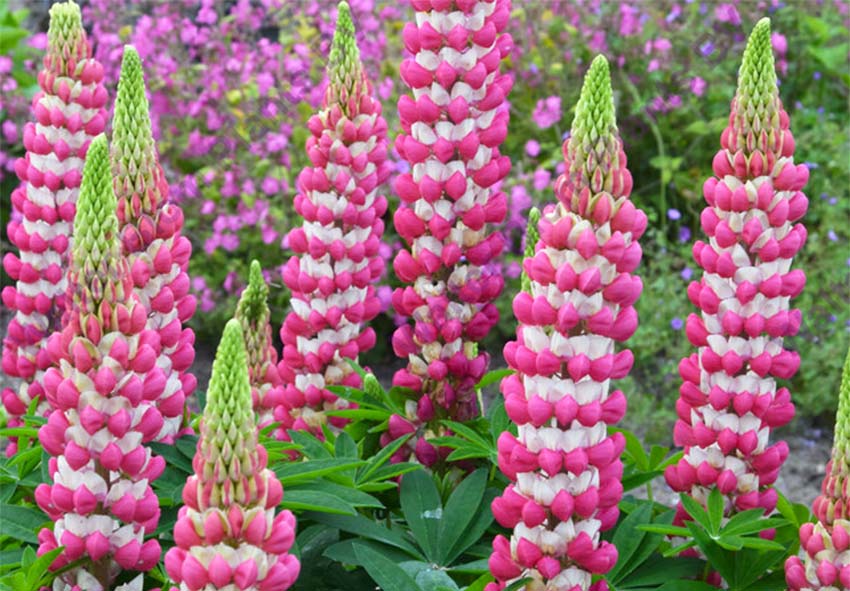
Lupinus, commonly known as lupines, are cherished for their vibrant, tall flower spikes and their ability to thrive in various garden settings. Understanding the characteristics, history, and benefits of Lupinus is the first step in successfully incorporating these striking plants into your garden.
Overview of Lupinus
Lupinus plants are known for their tall, spire-like blooms that come in a range of colors, from deep purples and blues to vibrant pinks, yellows, and whites. These plants belong to the legume family and are recognized for their ability to fix nitrogen in the soil, making them a valuable addition to any garden. Originating from North and South America, Lupinus species have been cultivated for centuries, not just for their beauty, but also for their ecological benefits.
Popular Varieties of Lupinus
There are many varieties of Lupinus, each offering unique characteristics:
| Botanical Name | Color | Flowering Period | Growing Climate | Usage |
| Lupinus polyphyllus | Blue, pink, white, purple, yellow | Late spring to early summer | Cool to temperate climates | Garden borders, cut flowers, pollinator gardens |
| Lupinus perennis | Blue, purple, pink | Late spring to early summer | Cool to temperate climates | Wildflower meadows, erosion control, pollinator gardens |
| Lupinus albus | White | Early to mid-summer | Mediterranean climates, well-drained soil | Cover crops, soil improvement, food production (seeds) |
| Lupinus arboreus | Yellow, occasionally blue | Late spring to early summer | Coastal climates, mild winters | Coastal gardens, erosion control, nitrogen fixation |
Benefits of Growing Lupinus
Lupinus plants offer several benefits to gardeners and the environment. Lupines are magnets for bees, butterflies, and hummingbirds, which are crucial for pollination in your garden. As nitrogen-fixers, Lupinus plants improve soil quality, making it more fertile for other plants. With their bold and beautiful flower spikes, Lupinus can dramatically enhance the aesthetic appeal of any garden.
How to Plant Lupinus
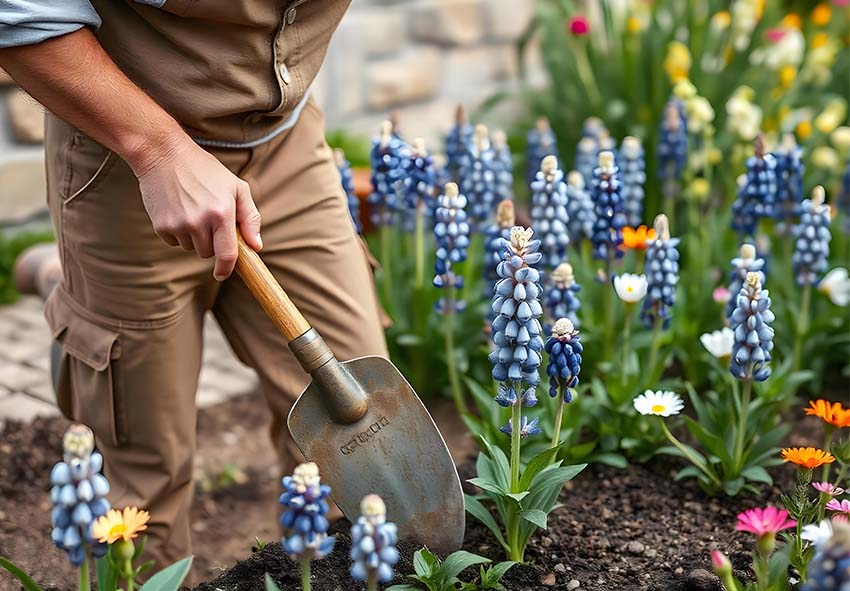
Planting Lupinus correctly is essential for ensuring their healthy growth and long-lasting blooms. This section covers the ideal growing conditions, soil preparation, and step-by-step planting techniques to help you establish a thriving Lupinus display in your garden.
Ideal Growing Conditions
To ensure successful growth, it’s important to provide Lupinus with the right environment:
- Soil requirements: Lupines prefer slightly acidic to neutral, well-draining soil. They thrive in sandy or loamy soils and do not tolerate waterlogged conditions.
- Sunlight and temperature preferences: These plants do best in full sun, requiring at least 6 hours of direct sunlight per day. Lupinus is generally hardy in USDA zones 4-8, tolerating a range of temperatures, but extreme heat may reduce flowering.
Preparing the Soil
Proper soil preparation is key to a thriving Lupinus plant. Before planting Lupinus, test your soil’s pH and nutrient levels. If necessary, amend the soil with organic matter or sand to improve drainage and acidity. Lupines are prone to root rot in poorly drained soils, so ensure that your garden bed has adequate drainage.
Step-by-Step Planting Guide
Follow these steps to plant Lupinus successfully:
- When to plant: Plant Lupinus seeds or transplants in early spring after the last frost, or in the fall for regions with mild winters. Fall planting can give the plants a head start for spring growth, especially in areas with cooler summers.
- Choosing the right spot: Select a location with full sun to partial shade. Lupinus thrives in areas that receive at least 6 hours of sunlight per day, but some afternoon shade can be beneficial in hotter climates.
- Soil preparation: Prepare the soil by loosening it to a depth of 12-15 inches. Amend with compost or organic matter to improve drainage and fertility, as Lupinus prefers well-drained, slightly acidic to neutral soil (pH 6.0-7.0).
- Planting depth and spacing: Sow seeds about ¼ inch deep and space them 12-24 inches apart to allow ample room for growth. If using transplants, dig a hole large enough to accommodate the root ball, place the plant, and backfill with soil, ensuring that the crown of the plant is level with the soil surface.
- Mulching: Apply a thin layer of mulch around the base of the plants to help retain moisture, regulate soil temperature, and suppress weeds. Use organic mulch like straw or bark, but avoid piling it directly against the stems to prevent rot.
- Watering after planting: Water the plants thoroughly after planting to help them establish roots. Maintain consistent moisture, especially during the first growing season, but avoid overwatering as Lupinus prefers slightly dry conditions once established. Reduce watering as the plants mature to prevent root rot.
- Fertilization: Lupinus generally does not require heavy fertilization, but a light application of a balanced fertilizer during planting can help promote healthy growth. Avoid excessive nitrogen, as it can lead to lush foliage at the expense of flowers.
Lupinus Care and Maintenance
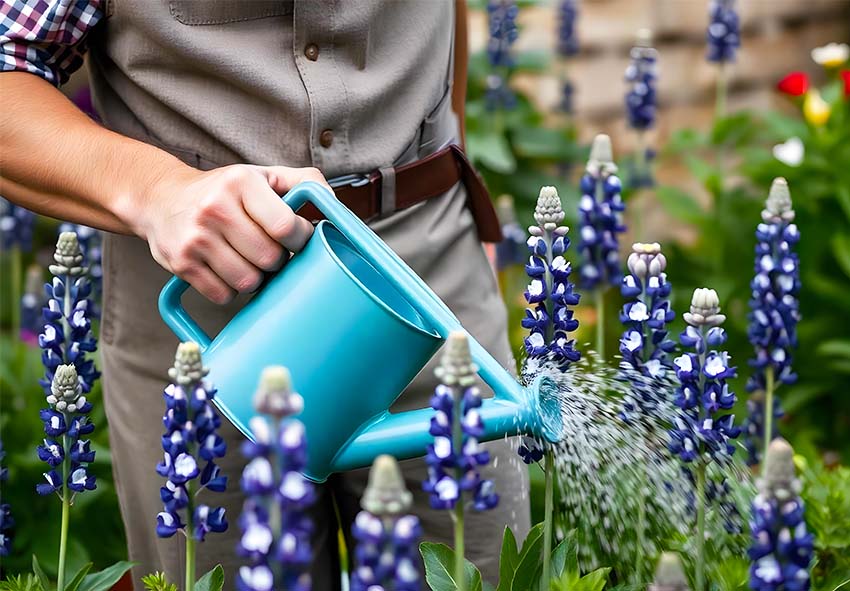
To keep your Lupinus plants healthy and flourishing, consistent care and maintenance are key. From proper watering and fertilization to pruning and providing support, this section provides detailed guidance on how to care for Lupinus throughout the growing season.
Watering and Fertilization
Consistent care is crucial for maintaining healthy Lupinus plants. Water Lupinus regularly during the growing season, especially in dry periods, but allow the soil to dry out slightly between waterings. Overwatering can lead to root rot, particularly in poorly drained soils. To strike the right balance, aim to water deeply once a week, increasing frequency during periods of drought.
Apply a balanced, slow-release fertilizer in early spring to promote vigorous growth and flowering. Avoid high-nitrogen fertilizers, which can lead to excessive foliage at the expense of flowers. Instead, consider using a fertilizer with higher phosphorus content to encourage blooming. Additionally, incorporating organic matter, such as compost, into the soil during planting can provide long-term nutrition.
Pruning and Deadheading
Proper pruning can enhance your Lupinus display. Cut back Lupinus plants in late summer or fall to remove spent flower spikes and encourage a second bloom. Pruning not only tidies the plant but also redirects energy into producing new blooms rather than sed production.
Regularly deadheading Lupinus will prolong the blooming period and prevent the plants from self-seeding excessively, which can help maintain garden order and control plant spread. For perennial Lupinus, cutting back the foliage after flowering can also rejuvenate the plant and promote healthy growth for the next season. Remember to use clean, sharp pruning shears to prevent disease transmission and ensure clean cuts.
Staking and Support
Tall Lupinus varieties may need additional support to prevent damage from wind and heavy rain. Use stakes or plant supports to keep tall Lupinus varieties upright, especially in windy conditions. It’s best to secure the plants early in the season, as they begin to grow, rather than waiting until they are fully grown and potentially top-heavy.
Bamboo stakes or metal plant rings can be used, and they should be placed close to the plant’s base without disturbing the root system. Tie the stems to the supports with soft garden ties, ensuring they are snug but not too tight to allow for natural growth. This support is crucial during stormy weather or when the flowers are in full bloom, as the weight of the blooms can cause the stems to bend or break. Regularly check and adjust the ties as the plants grow to avoid constriction.
Pests and Diseases in Lupinus
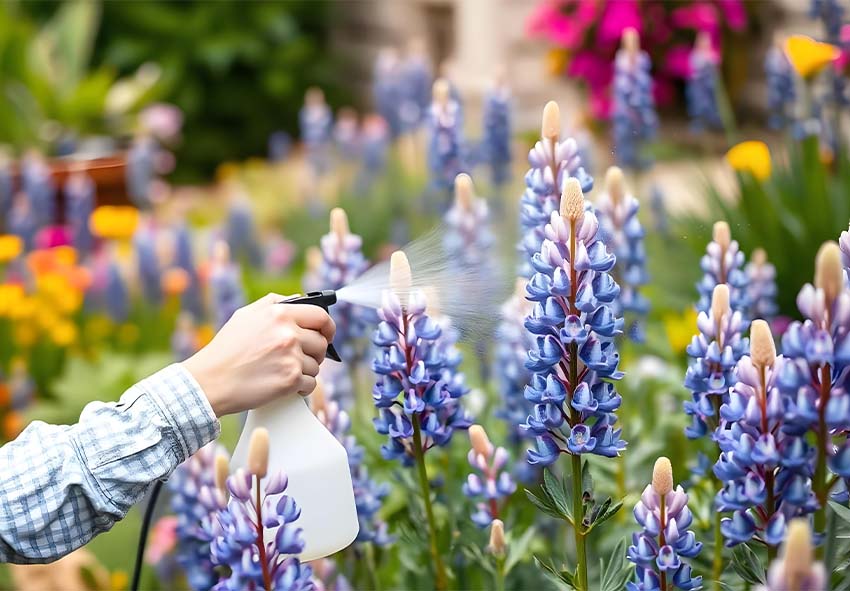
Lupinus can be susceptible to various pests and diseases that may impact their growth. Identifying common threats and learning how to manage them effectively will help you protect your plants and maintain a beautiful Lupinus garden.
Common Pests
Lupinus can be susceptible to various pests:
- Aphids: These small, sap-sucking insects can weaken Lupinus plants by draining their nutrients. Control them with insecticidal soap or by introducing natural predators like ladybugs.
- Slugs and snails: These pests can damage Lupinus by eating holes in the leaves. Use slug traps or copper tape to protect your plants.
- Other pests: Watch out for weevils, which can chew on Lupinus leaves, and manage them with appropriate pesticides or by removing them by hand.
Diseases and Solutions
Lupinus plants can also suffer from several diseases:
- Powdery mildew: This fungal disease appears as a white, powdery coating on the leaves. Prevent it by ensuring good air circulation around the plants and treating with fungicides if necessary.
- Root rot: Caused by waterlogged soil, root rot can be deadly for Lupinus. Prevent it by planting in well-drained soil and avoiding overwatering.
- Preventative measures: Regularly inspect your plants for signs of disease, remove affected foliage, and maintain proper spacing to reduce the risk of fungal infections.
Designing Your Garden with Lupinus
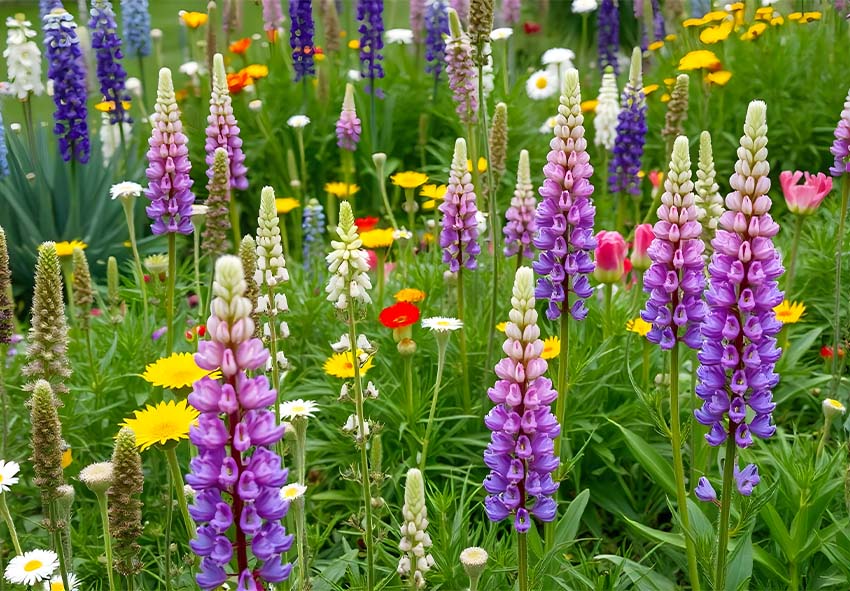
Lupinus plants can be a stunning addition to many garden styles. Whether you’re designing a cottage garden, a wildflower meadow, or a pollinator-friendly space, this section offers tips on pairing Lupinus with complementary plants and creating aesthetically pleasing garden designs.
Companion Plants for Lupinus
Lupinus pairs well with several other plants. Plant Lupinus alongside other tall perennials like Delphiniums, Foxgloves, and Echinacea for a stunning garden display. Mix Lupinus with ornamental grasses and low-growing ground covers to create a balanced and visually appealing garden.
Using Lupinus in Different Garden Styles
Lupinus is a versatile plant that can be seamlessly incorporated into various garden designs, adding vibrant color and unique structure to your outdoor spaces. Here’s how Lupinus can enhance different types of gardens:
- Cottage Gardens: Lupinus is a quintessential choice for cottage gardens, where its colorful spikes can be beautifully intermingled with other flowering plants like roses, hollyhocks, and foxgloves. The tall, striking flower spikes of Lupinus provide vertical interest, creating a charming, layered effect in informal, cottage-style settings. Their range of colors—from soft pastels to deep purples and reds—complements the lush, diverse plantings typically found in cottage gardens.
- Wildflower Meadows: In wildflower meadows, Lupinus plays a crucial role in adding structure and vibrant color. Their bold, upright flowers stand out amidst the more delicate, free-flowing blooms of other wildflowers, such as poppies and daisies. Lupinus not only enhances the aesthetic appeal of these naturalistic settings but also contributes to the ecological health of the meadow by fixing nitrogen in the soil, which benefits surrounding plants.
- Pollinator Gardens: Lupinus is a magnet for pollinators, making it an excellent addition to pollinator gardens designed to attract bees, butterflies, and other beneficial insects. The plant’s brightly colored flowers and rich nectar provide an essential food source for pollinators, helping to support their populations. By incorporating Lupinus into a pollinator garden, you create a vibrant, dynamic space that contributes to biodiversity and the health of your local ecosystem.
- Formal Gardens: While Lupinus is often associated with more informal settings, it can also be used effectively in formal gardens. Planted in structured rows or grouped by color, Lupinus can add a touch of elegance and height to formal borders or symmetrical garden designs. Their tall flower spikes can serve as focal points or be used to create a rhythmic pattern in the landscape.
- Container Gardens: For those with limited garden space, Lupinus can be successfully grown in containers, adding a splash of color to patios, balconies, or small garden areas. When grown in containers, Lupinus provides the same visual appeal as in-ground plantings but with the added flexibility of being able to move the plants to different locations as needed. Ensure the containers are deep enough to accommodate their root system and use well-draining soil to prevent waterlogging.
Incorporating Lupinus into these various garden designs allows you to take full advantage of its aesthetic and ecological benefits, creating a garden space that is both beautiful and functional. Whether you’re looking to attract pollinators, add structure to a wildflower meadow, or create a vibrant focal point in a cottage garden, Lupinus offers a versatile and rewarding option.
Harvesting and Using Lupinus

Beyond their beauty in the garden, Lupinus plants offer seeds that can be harvested and used for future planting. Additionally, their striking flowers can be cut and arranged to create stunning floral displays. This section guides you through the process of harvesting seeds and using Lupinus in various creative ways.
When and How to Harvest Lupinus Seeds
Harvesting seeds from Lupinus is a simple process. Collect Lupinus seeds in late summer or early fall, once the seed pods have dried and turned brown. Gently open the seed pods and remove the seeds. Store them in a cool, dry place until you’re ready to plant them next season.
Using Lupinus in Floral Arrangements
Lupinus flowers make stunning additions to bouquets. Cut Lupinus flowers early in the morning when they’re fresh, and immediately place them in water. Remove any leaves that would be submerged in water to prolong the life of the blooms. Combine Lupinus with other garden flowers like roses and peonies for a full, vibrant arrangement. Their tall spikes add height and drama to any floral display.
Conclusion
Lupinus is a versatile and beautiful addition to any garden, offering vibrant colors and numerous ecological benefits. By understanding the ideal conditions for planting, the proper care techniques, and the potential challenges, you can enjoy a thriving display of Lupinus year after year. Experiment with different varieties and companion plants to create a stunning and dynamic garden that attracts pollinators and enhances the beauty of your outdoor space.
Frequently Asked Questions (FAQs) about Lupinus
1. When is the best time to plant Lupinus seeds?
The best time to plant Lupinus seeds is in early spring after the last frost, or in the fall if you live in a region with mild winters. Fall planting allows the seeds to establish before the growing season, while spring planting takes advantage of warming soil temperatures for faster germination.
2. How often should I water Lupinus plants?
Lupinus plants prefer consistent moisture, especially during the growing season. Water regularly, allowing the soil to dry out slightly between waterings. Overwatering should be avoided, as Lupinus thrives in well-drained soil. In dry climates or during droughts, increase watering frequency to prevent the plants from wilting.
3. Do Lupinus plants need fertilizer?
Yes, Lupinus plants benefit from a balanced, slow-release fertilizer applied in early spring. This helps promote healthy growth and vibrant blooms. Avoid fertilizers high in nitrogen, as they can encourage excessive foliage growth at the expense of flowers. Instead, opt for a fertilizer formulated for flowering plants.
4. Can I order lupinus plants from your online store?
We are pleased to offer a variety of lupinus for sale. Our selection includes different lupinus cultivars, each with its unique foliage and characteristics. You can browse our online store Dutch-bulbs.com to explore the options, and with a few clicks, you can have lupinus plants delivered to your doorstep.
5. How can I prevent pests and diseases in Lupinus?
To prevent pests and diseases in Lupinus, ensure proper spacing for good air circulation, water at the base of the plant to avoid wetting the foliage, and use well-draining soil. Regularly inspect plants for signs of aphids, slugs, or powdery mildew, and apply appropriate treatments as soon as issues arise.
Published: 13.09.2024
